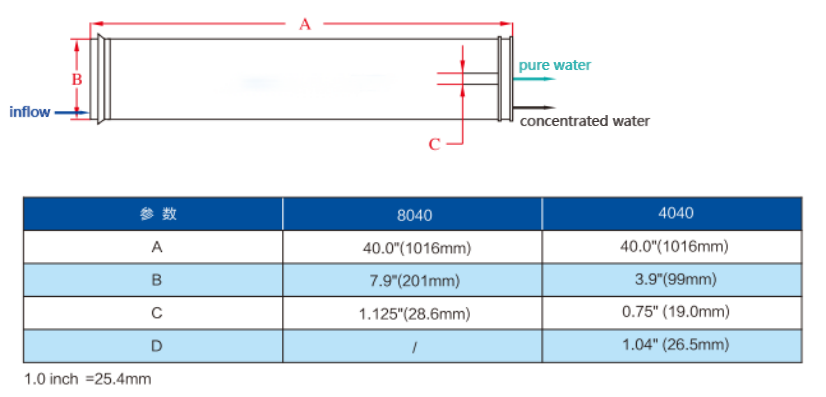BSSTREAT* BW-8040FR

product description
The BSSTREAT* BW-8040FR membrane is an anti-fouling aromatic polyamide composite reverse osmosis (RO) membrane element designed for complex feed water conditions. This series employs a specialized membrane-forming process that enhances the hydrophilicity, charge characteristics, and roughness of the membrane sheet, effectively reducing microbial growth and contaminant adhesion on the membrane surface during operation. Featuring a 34-mil wide flow channel design, the membrane element minimizes fouling, lowers system pressure drop, and enables easy cleaning to extend service life.
This technology is primarily used for desalination treatment of water sources with salt concentrations below 10,000 mg/L, including reclaimed water, wastewater, and RO concentrate. Its applications span multiple industries such as power generation, steel manufacturing, electroplating, petrochemicals, coal chemical processing, textile dyeing, and municipal wastewater treatment. The system features superior desalination performance, excellent cleaning recovery capability, and low pressure drop (the differential pressure between the inlet water of pressure vessels and concentrate).
Model and performance parameters
|
model |
Effective membrane area ft2(m2) |
Inflow channel (mil) |
water yield GPD(m3/d) |
Stable desalination rate(%) |
Minimum desalination rate(%) |
|
BSSTREAT* BW-8040FR |
400(37.2) |
34 |
10500(39.7) |
99.7 |
99
|
Product Notes
|
Test liquid |
water temperature (℃) |
pH price |
Test pressure psi (MPa) |
retrieve(%) |
|
2000mg/L NaCl |
25 |
7.5-8.0 |
225(1.55) |
15 |
A The above performance parameters are obtained based on the following test conditions:
B The yield of a single B component may fluctuate within the range of ±15%.
C operative limits :
Maximum operating pressure •••••••••••••••••••••••••••••••••••••••••••••••••••600psi(4.14MPa)
Maximum water inflow flow rate ••••••••••••••••••••••••••••••••••••••••••••••••17.0m3/h (8040)
Maximum inlet water temperature•••••••••••••••••••••••••••••••••••••••••••••••••••••••••0-45℃
Maximum water intake SDI15••••••••••••••••••••••••••••••••••••••••••••••••••••••••••••••••••5.0
Maximum residual chlorine concentration••••••••••••••••••••••••••••••••••••••••••••••••0.1mg/L
Continuous operation inlet pH range •••••••••••••••••••••••••••••••••••••••••••••••••••••••• 3-10
Chemical cleaning when inlet water pH range••••••••••••••••••••••••••••••••••••••••••••••••1-13
Maximum allowable voltage drop of single diaphragm element ••••••••••••••••••15psi(0.1MPa)

leaning steps
A low pressure rinse is performed on the membrane system with product water.
B Prepare the relevant cleaning solution in the cleaning tank (use product water to prepare, control the pH value and temperature of the cleaning solution).
C Open and close the corresponding valve to form a circulating medicine washing pipeline; start the cleaning pump, inject the cleaning solution into the pressure vessel of the membrane element, and start the circulating cleaning operation. The time of a cycle cleaning is (1-2) hours.
D The circulation cleaning starts for 5 minutes, and the circulation cleaning is carried out according to 1/3 of the set flow rate. Then every 10 minutes, the circulation flow rate is gradually increased from 2/3 of the set flow rate to full flow rate.
E After the first cleaning, the membrane element must be rinsed clean with product water, and then another cleaning solution is used for cleaning.
F The turbidity and pH value of the concentrated water are detected in real time. When the turbidity or pH value changes by more than 0.5 units, the cleaning solution should be supplemented or reconfigured.
After
G cleaning, the system is first rinsed under low pressure, and the air is gradually discharged and pressurized until the water produced is qualified.
H If the membrane element is severely blocked, or the water production recovery after cleaning is not obvious, the cleaning solution can be pumped into the membrane element pressure vessel again, so that the cleaning solution is kept in the membrane shell to soak the membrane element (6-12) hours, and then carry out the circulating cleaning.
I For the cleaning, flushing and soaking of the "multi-stage system", the process can be carried out simultaneously in all stages; however, the high flow circulation cleaning process must be carried out in segments to facilitate the control of the circulation flow during cleaning in each stage.
matters need attention
A Before the chemical cleaning begins, ensure that the chemicals used to prepare the cleaning solution are fully dissolved and mixed.
B The "low pressure and high flow rate" cleaning of the membrane system will result in high pressure drop. Attention should be paid to the maximum allowable pressure drop of 0.1MPa or 15psi for a single component inlet water and concentrated water, and 0.35MPa or 50psi for a multi-component pressure vessel.
C cleaning pH limit: When the pH of the cleaning solution is 1 or 13, it can effectively clean scale, organic compounds and biofilm. Under the condition of cleaning at this limit pH value, the temperature of the cleaning solution must be controlled to ensure that the membrane element is not damaged.
D Temperature Limits for Cleaning: During routine chemical cleaning, the solution temperature should be maintained between (30-35)°C. For extreme cleaning conditions, the temperature must be kept below 30°C. Chemical cleaning should generally be avoided in low-temperature environments. The solution temperature should be maintained at ≥20°C to ensure cleaning efficiency and prevent sediment formation.
E After chemical cleaning, before the normal operation of the membrane system is restored, the membrane system must be rinsed with the water produced by the system or the water that meets the inlet requirements of the membrane system. The chemical cleaning is considered to be completed only after the residual cleaning solution in the system is completely rinsed.
Innovation >Technology >Future
SOAP Technology and Solutions Product Description
